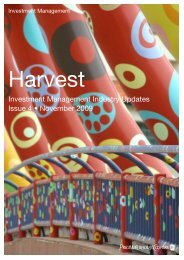You also want an ePaper? Increase the reach of your titles
YUMPU automatically turns print PDFs into web optimized ePapers that Google loves.
B. Tax exemption schemes for Singapore funds<br />
As mentioned earlier, several tax exemption schemes<br />
are available for funds set up in Singapore, which cater<br />
for different circumstances. In the following sections,<br />
we will discuss two such schemes.<br />
(i) Singapore-resident Fund Company Scheme<br />
The tax exemption scheme for Singaporeresident<br />
fund companies (the “SRF Scheme”) was<br />
introduced in November 2006 to further develop<br />
the Singapore asset management industry. The<br />
SRF Scheme grants tax exemption for ’specified<br />
income‘ in respect of any ‘designated investment’<br />
derived by any approved Singapore-resident fund<br />
set up as a company that satisfies the ’qualifying<br />
fund‘ test.<br />
To enjoy tax exemption under the SRF Scheme,<br />
an application has to be submitted to the MAS.<br />
To be approved, a fund must undertake to meet<br />
the prescribed conditions, including the conditions<br />
that it:<br />
• is a tax resident of Singapore where the control<br />
and management is exercised in Singapore<br />
(i.e. the fund company’s board meetings must<br />
be held in Singapore);<br />
• is a company the value of issued securities<br />
of which is not 100% beneficially owned,<br />
directly or indirectly, by investors in Singapore<br />
(including investors who are resident<br />
individuals, resident non-individuals and<br />
permanent establishments in Singapore); and<br />
• uses a Singapore-based fund administrator.<br />
The investors will be split into two categories –<br />
qualifying investors and non-qualifying investors.<br />
A non-qualifying investor will have to pay a financial<br />
penalty to the IRAS. The financial penalty is<br />
calculated by attributing a percentage of the net<br />
profits in the fund’s audited accounts to that nonqualifying<br />
investor based on his interest in the fund<br />
on the last day of the financial year of the fund.<br />
The main type of investor who will be considered<br />
a non-qualifying investor appears to be a nonindividual<br />
person based in Singapore (other than<br />
certain Singapore government entities) who take<br />
large (more than 30%) stakes in the fund.<br />
An approved fund is required to comply with certain<br />
reporting/tax return filing obligations.<br />
(ii) Enhanced-Tier Fund Tax Incentive Scheme<br />
To provide Singapore-based fund managers with<br />
greater flexibility in sourcing for mandates, the MAS<br />
issued a circular on 30 April 2009 providing details<br />
of the Enhanced-Tier Fund Tax Incentive Scheme<br />
(“ET Scheme”) for fund vehicles. The key benefit of<br />
the ET Scheme is that the concept of qualifying and<br />
non-qualifying investors is not relevant under this<br />
scheme, and thus no investor is liable to a financial<br />
penalty. Also, under this scheme, fund vehicles can<br />
be set up as limited partnerships.<br />
Funds approved under the ET Scheme (“ET Funds”)<br />
will be granted tax exemption for ‘specified income’<br />
in respect of any ‘designated investment’. To<br />
be approved for the ET Scheme, the fund must<br />
undertake to meet the prescribed conditions,<br />
including the conditions that it:<br />
• is a company, trust (other than a trust that is an<br />
approved pension or approved provident fund<br />
under section 5 of the Singapore Income Tax<br />
(Chapter 134), an approved CPF unit trust or<br />
designated unit trust, or a real estate investment<br />
trust) or limited partnership;<br />
• has a minimum fund size of S$50 million at the<br />
point of application; and<br />
• uses a Singapore-based fund administrator if the<br />
fund is a company incorporated in Singapore,<br />
with its tax residency in Singapore.<br />
All ET Funds are required to comply with certain<br />
reporting/tax return filing obligations.<br />
Conclusion<br />
In contrast to other fund locations, Singapore should stand<br />
out as a viable option, as it is possible to demonstrate<br />
substance out of Singapore where actual business<br />
activities can be conducted, thereby providing stronger<br />
grounds for claiming DTA benefits. The fund structure may<br />
also be simplified, reducing overall compliance costs.<br />
These benefits would need to be weighed against potential<br />
tax leakages on account of GST and withholding tax, and<br />
the issue of investor familiarity with Singapore. However, it<br />
is fair to say that serious consideration should be given to<br />
using Singapore as a fund location before the set-up of any<br />
fund structure, with a view to improving overall economic<br />
returns for the two key stakeholders – the investors and the<br />
fund manager.



